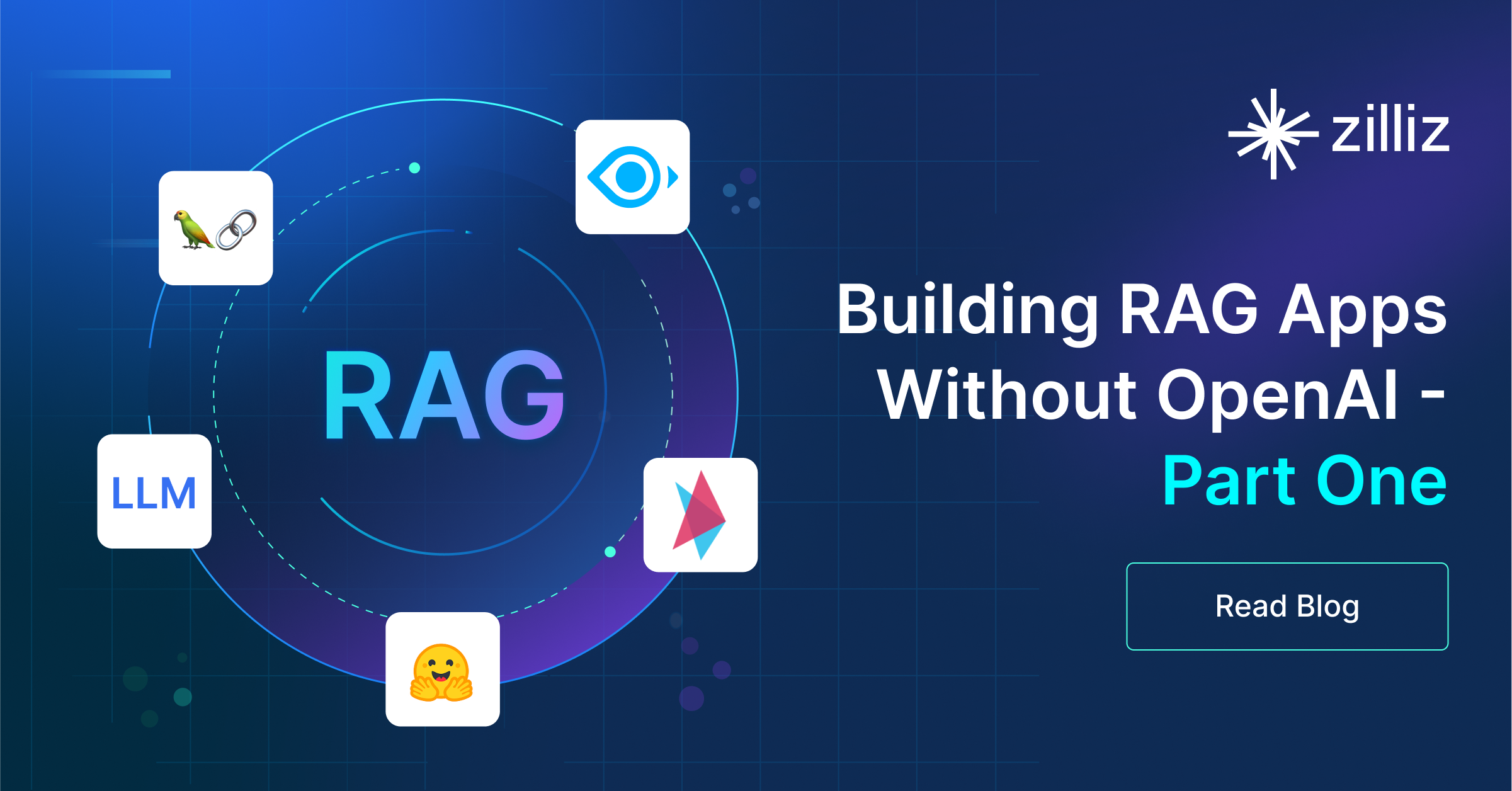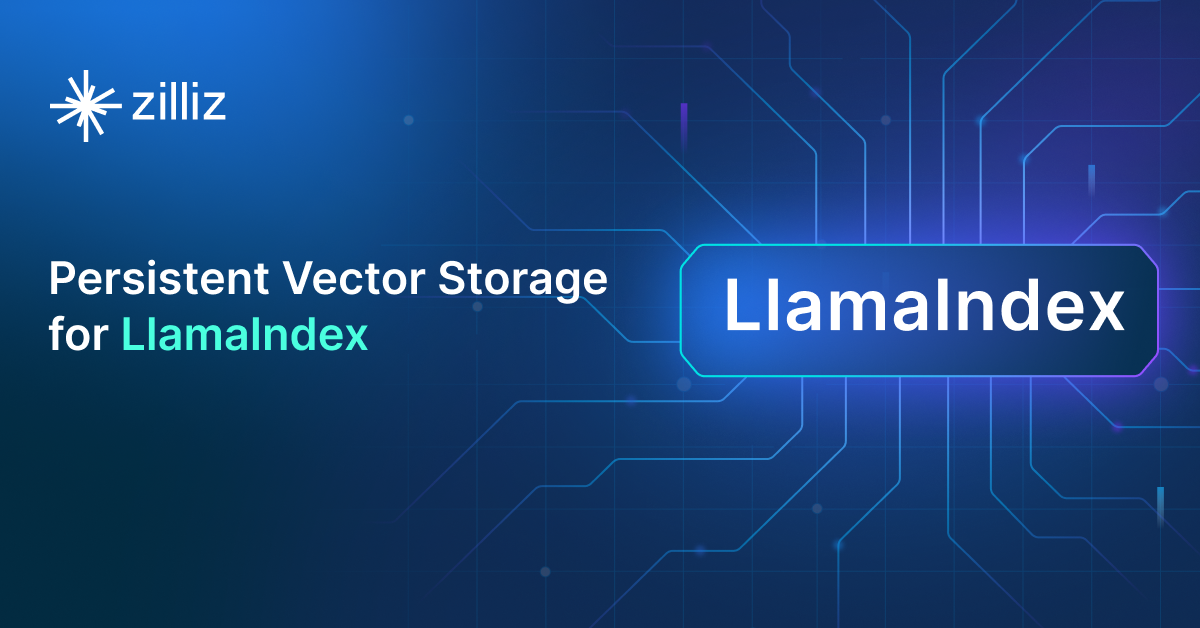Build RAG Chatbot with LangChain, Zilliz Cloud, NVIDIA Qwen2.5-7B-Instruct, and NVIDIA nv-embed-v1
Introduction to RAG
Retrieval-Augmented Generation (RAG) is a game-changer for GenAI applications, especially in conversational AI. It combines the power of pre-trained large language models (LLMs) like OpenAI’s GPT with external knowledge sources stored in vector databases such as Milvus and Zilliz Cloud, allowing for more accurate, contextually relevant, and up-to-date response generation. A RAG pipeline usually consists of four basic components: a vector database, an embedding model, an LLM, and a framework.
Key Components We'll Use for This RAG Chatbot
This tutorial shows you how to build a simple RAG chatbot in Python using the following components:
- LangChain: An open-source framework that helps you orchestrate the interaction between LLMs, vector stores, embedding models, etc, making it easier to integrate a RAG pipeline.
- Zilliz Cloud: a fully managed vector database-as-a-service platform built on top of the open-source Milvus, designed to handle high-performance vector data processing at scale. It enables organizations to efficiently store, search, and analyze large volumes of unstructured data, such as text, images, or audio, by leveraging advanced vector search technology. It offers a free tier supporting up to 1 million vectors.
- NVIDIA Qwen2.5-7B-Instruct: This advanced language model is designed for instruction-following tasks, leveraging the capabilities of 7 billion parameters to comprehend and generate diverse text responses. Its strengths lie in natural language understanding and contextual adaptability, making it ideal for applications in tutoring, conversational agents, and automated content generation across various domains.
- NVIDIA nv-embed-v1: This model specializes in generating high-quality embeddings for various applications, such as image and text processing. Its strength lies in efficiently capturing semantic similarities and contextual information. Ideal for tasks like semantic search, recommendation systems, and natural language understanding, it facilitates advanced AI solutions across diverse industries.
By the end of this tutorial, you’ll have a functional chatbot capable of answering questions based on a custom knowledge base.
Note: Since we may use proprietary models in our tutorials, make sure you have the required API key beforehand.
Step 1: Install and Set Up LangChain
%pip install --quiet --upgrade langchain-text-splitters langchain-community langgraph
Step 2: Install and Set Up NVIDIA Qwen2.5-7B-Instruct
pip install -qU "langchain-nvidia-ai-endpoints"
import getpass
import os
if not os.environ.get("NVIDIA_API_KEY"):
os.environ["NVIDIA_API_KEY"] = getpass.getpass("Enter API key for NVIDIA: ")
from langchain.chat_models import init_chat_model
llm = init_chat_model("qwen/qwen2.5-7b-instruct", model_provider="nvidia")
Step 3: Install and Set Up NVIDIA nv-embed-v1
pip install -qU langchain-nvidia-ai-endpoints
import getpass
import os
if not os.environ.get("NVIDIA_API_KEY"):
os.environ["NVIDIA_API_KEY"] = getpass.getpass("Enter API key for NVIDIA: ")
from langchain_nvidia_ai_endpoints import NVIDIAEmbeddings
embeddings = NVIDIAEmbeddings(model="nvidia/nv-embed-v1")
Step 4: Install and Set Up Zilliz Cloud
pip install -qU langchain-milvus
from langchain_milvus import Zilliz
vector_store = Zilliz(
embedding_function=embeddings,
connection_args={
"uri": ZILLIZ_CLOUD_URI,
"token": ZILLIZ_CLOUD_TOKEN,
},
)
Step 5: Build a RAG Chatbot
Now that you’ve set up all components, let’s start to build a simple chatbot. We’ll use the Milvus introduction doc as a private knowledge base. You can replace it with your own dataset to customize your RAG chatbot.
import bs4
from langchain import hub
from langchain_community.document_loaders import WebBaseLoader
from langchain_core.documents import Document
from langchain_text_splitters import RecursiveCharacterTextSplitter
from langgraph.graph import START, StateGraph
from typing_extensions import List, TypedDict
# Load and chunk contents of the blog
loader = WebBaseLoader(
web_paths=("https://milvus.io/docs/overview.md",),
bs_kwargs=dict(
parse_only=bs4.SoupStrainer(
class_=("doc-style doc-post-content")
)
),
)
docs = loader.load()
text_splitter = RecursiveCharacterTextSplitter(chunk_size=1000, chunk_overlap=200)
all_splits = text_splitter.split_documents(docs)
# Index chunks
_ = vector_store.add_documents(documents=all_splits)
# Define prompt for question-answering
prompt = hub.pull("rlm/rag-prompt")
# Define state for application
class State(TypedDict):
question: str
context: List[Document]
answer: str
# Define application steps
def retrieve(state: State):
retrieved_docs = vector_store.similarity_search(state["question"])
return {"context": retrieved_docs}
def generate(state: State):
docs_content = "\n\n".join(doc.page_content for doc in state["context"])
messages = prompt.invoke({"question": state["question"], "context": docs_content})
response = llm.invoke(messages)
return {"answer": response.content}
# Compile application and test
graph_builder = StateGraph(State).add_sequence([retrieve, generate])
graph_builder.add_edge(START, "retrieve")
graph = graph_builder.compile()
Test the Chatbot
Yeah! You've built your own chatbot. Let's ask the chatbot a question.
response = graph.invoke({"question": "What data types does Milvus support?"})
print(response["answer"])
Example Output
Milvus supports various data types including sparse vectors, binary vectors, JSON, and arrays. Additionally, it handles common numerical and character types, making it versatile for different data modeling needs. This allows users to manage unstructured or multi-modal data efficiently.
Optimization Tips
As you build your RAG system, optimization is key to ensuring peak performance and efficiency. While setting up the components is an essential first step, fine-tuning each one will help you create a solution that works even better and scales seamlessly. In this section, we’ll share some practical tips for optimizing all these components, giving you the edge to build smarter, faster, and more responsive RAG applications.
LangChain optimization tips
To optimize LangChain, focus on minimizing redundant operations in your workflow by structuring your chains and agents efficiently. Use caching to avoid repeated computations, speeding up your system, and experiment with modular design to ensure that components like models or databases can be easily swapped out. This will provide both flexibility and efficiency, allowing you to quickly scale your system without unnecessary delays or complications.
Zilliz Cloud optimization tips
Optimizing Zilliz Cloud for a RAG system involves efficient index selection, query tuning, and resource management. Use Hierarchical Navigable Small World (HNSW) indexing for high-speed, approximate nearest neighbor search while balancing recall and efficiency. Fine-tune ef_construction and M parameters based on your dataset size and query workload to optimize search accuracy and latency. Enable dynamic scaling to handle fluctuating workloads efficiently, ensuring smooth performance under varying query loads. Implement data partitioning to improve retrieval speed by grouping related data, reducing unnecessary comparisons. Regularly update and optimize embeddings to keep results relevant, particularly when dealing with evolving datasets. Use hybrid search techniques, such as combining vector and keyword search, to improve response quality. Monitor system metrics in Zilliz Cloud’s dashboard and adjust configurations accordingly to maintain low-latency, high-throughput performance.
NVIDIA Qwen2.5-7B-Instruct Optimization Tips
To optimize the NVIDIA Qwen2.5-7B-Instruct model in a Retrieval-Augmented Generation (RAG) setup, consider implementing mixed precision training to reduce memory footprint and accelerate training times. Fine-tune the model on domain-specific data to enhance relevancy in generated responses while adjusting the retrieval component's cosine similarity threshold to balance precision and recall. Utilize an efficient caching mechanism to store frequently accessed data, ensuring low-latency responses. Experiment with varying the number of retrievals based on query complexity, and leverage batch processing during inference to maximize throughput. Finally, keep an eye on hardware utilization metrics to adjust configurations and achieve optimal performance.
NVIDIA nv-embed-v1 Optimization Tips
To optimize the NVIDIA nv-embed-v1 within a Retrieval-Augmented Generation (RAG) setup, ensure you fine-tune your models with domain-specific data to improve relevance and accuracy. Utilize mixed precision training to speed up training times and reduce memory usage. Implement efficient batching techniques to handle larger datasets, maximizing throughput. Leverage NVIDIA’s TensorRT for inference optimization, enabling faster response times during retrieval. Lastly, monitor GPU utilization and experiment with various hyperparameters, such as learning rates and dropout rates, for optimal performance tailored to your application needs.
By implementing these tips across your components, you'll be able to enhance the performance and functionality of your RAG system, ensuring it’s optimized for both speed and accuracy. Keep testing, iterating, and refining your setup to stay ahead in the ever-evolving world of AI development.
RAG Cost Calculator: A Free Tool to Calculate Your Cost in Seconds
Estimating the cost of a Retrieval-Augmented Generation (RAG) pipeline involves analyzing expenses across vector storage, compute resources, and API usage. Key cost drivers include vector database queries, embedding generation, and LLM inference.
RAG Cost Calculator is a free tool that quickly estimates the cost of building a RAG pipeline, including chunking, embedding, vector storage/search, and LLM generation. It also helps you identify cost-saving opportunities and achieve up to 10x cost reduction on vector databases with the serverless option.
 Calculate your RAG cost
Calculate your RAG cost
What Have You Learned?
By now, you’ve seen how powerful it is to combine cutting-edge tools like LangChain, Zilliz Cloud, NVIDIA’s Qwen2.5-7B-Instruct, and the nv-embed-v1 model into a seamless RAG pipeline! You learned how LangChain acts as the glue, orchestrating the flow of data between components—like chunking your documents, sending text to the NVIDIA embedding model to convert them into vectors, and efficiently storing those vectors in Zilliz Cloud’s scalable database. Then, when a query comes in, Zilliz retrieves the most relevant context, and NVIDIA’s Qwen2.5-7B-Instruct LLM transforms that raw data into clear, accurate answers. It’s like watching magic happen: the framework handles the logistics, the vector database nails precision, the embedding model captures nuance, and the LLM delivers human-like responses. Plus, you picked up optimization tricks, like tweaking chunk sizes for speed or using metadata filtering in Zilliz to refine results—pro tips that make your system faster and smarter without extra cost.
But wait, there’s more! The tutorial also introduced you to a free RAG cost calculator to estimate expenses and optimize resource usage, empowering you to build efficiently from day one. Imagine what you can do next: customize this pipeline for your own data, experiment with hybrid search strategies, or even fine-tune the LLM for niche domains. You’ve got the tools, the knowledge, and the playbook—now it’s your turn to create. Whether you’re building a chatbot, a research assistant, or an enterprise search tool, you’re ready to innovate. So fire up your code editor, experiment fearlessly, and see how far your RAG applications can go. The future of intelligent systems is in your hands—let’s build something amazing! 🚀
Further Resources
🌟 In addition to this RAG tutorial, unleash your full potential with these incredible resources to level up your RAG skills.
- How to Build a Multimodal RAG | Documentation
- How to Enhance the Performance of Your RAG Pipeline
- Graph RAG with Milvus | Documentation
- How to Evaluate RAG Applications - Zilliz Learn
- Generative AI Resource Hub | Zilliz
We'd Love to Hear What You Think!
We’d love to hear your thoughts! 🌟 Leave your questions or comments below or join our vibrant Milvus Discord community to share your experiences, ask questions, or connect with thousands of AI enthusiasts. Your journey matters to us!
If you like this tutorial, show your support by giving our Milvus GitHub repo a star ⭐—it means the world to us and inspires us to keep creating! 💖
- Introduction to RAG
- Key Components We'll Use for This RAG Chatbot
- Step 1: Install and Set Up LangChain
- Step 2: Install and Set Up NVIDIA Qwen2.5-7B-Instruct
- Step 3: Install and Set Up NVIDIA nv-embed-v1
- Step 4: Install and Set Up Zilliz Cloud
- Step 5: Build a RAG Chatbot
- Optimization Tips
- RAG Cost Calculator: A Free Tool to Calculate Your Cost in Seconds
- What Have You Learned?
- Further Resources
- We'd Love to Hear What You Think!
Content
Vector Database at Scale
Zilliz Cloud is a fully-managed vector database built for scale, perfect for your RAG apps.
Try Zilliz Cloud for Free


